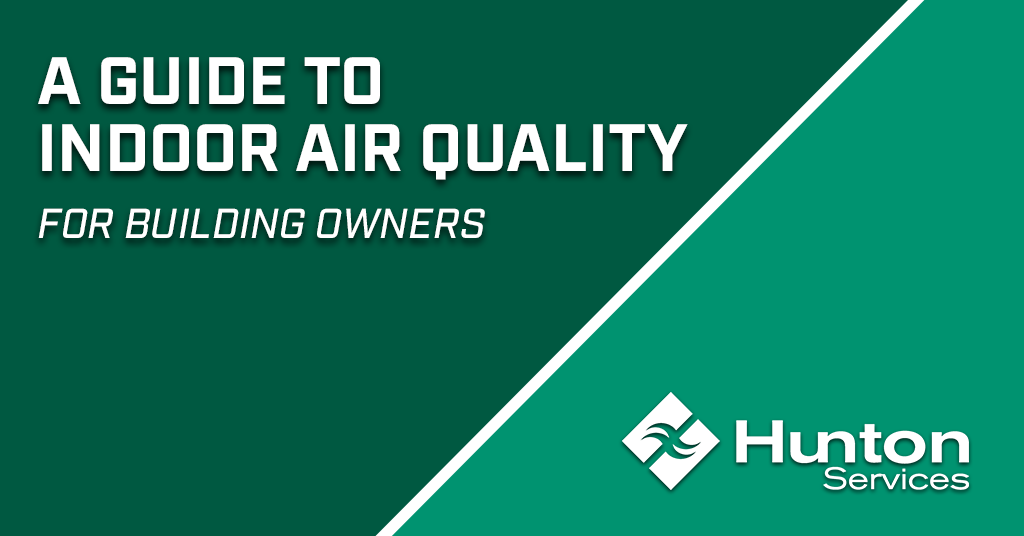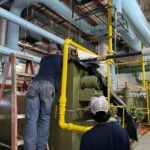A Guide to Indoor Air Quality for Building Owners
DESIGN, MAINTENANCE & OPERATION OF BUILDING VENTILATION SYSTEMS
Maintaining good indoor air quality requires attention to the building’s heating, ventilation and air conditioning (HVAC) system; the design and layout of the space; and pollutant source management. HVAC systems include all the equipment used to ventilate, heat, and cool the building; to move the air around the building (ductwork); and to filter and clean the air. These systems can have a significant impact on how pollutants are distributed and removed. HVAC systems can even act as sources of pollutants in some cases, such as when ventilation air filters become contaminated with dirt and/or moisture and when microbial growth results from stagnant water in drip pans or from uncontrolled moisture inside of air ducts.
Because of the HVAC system’s importance, good indoor air quality management includes attention to:
VENTILATION SYSTEM DESIGN – The air delivery capacity of an HVAC system is based in part on the projected number of people and amount of equipment in a building. When areas in a building are used differently than their original purpose, the HVAC system may require modification to accommodate these changes. For example, if a storage area is converted into space occupied by people, the HVAC system may require alteration to deliver enough conditioned air to the space.
OUTSIDE AIR SUPPLY – Adequate supply of outside air, typically delivered through the HVAC system, is necessary in any office environment to dilute pollutants that are released by equipment, building materials, furnishings, products, and people. Distribution of ventilation air to occupied spaces is essential for comfort.
OUTDOOR AIR QUALITY – When present, outdoor air pollutants such as carbon monoxide, pollen, and dust may affect indoor conditions when outside air is taken into the building’s ventilation system. Properly installed and maintained filters can trap many of the particles in this outdoor supply air. Controlling gaseous or chemical pollutants may require more specialized filtration equipment.
SPACE PLANNING – The use and placement of furniture and equipment may affect the delivery of air to an occupied space. For instance, the placement of heat generating equipment, like a computer, directly under an HVAC control device such as a thermostat may cause the HVAC system to deliver too much cool air, because the thermostat senses that the area is too warm. Furniture or partitions that block supply or return air registers can affect IAQ as well and need to be positioned with attention to air flow.
EQUIPMENT MAINTENANCE – Diligent maintenance of HVAC equipment is essential for the adequate delivery and quality of building air. All well-run buildings have preventive maintenance programs that help ensure the proper functioning of HVAC systems.
CONTROLLING OTHER POLLUTANT PATHWAYS – Pollutants can spread throughout a building by moving through stairwells, elevator shafts, wall spaces, and utility chases. Special ventilation or other control measures may be needed for some sources.
WHAT BUILDING FACILITY MANAGERS CAN DO TO PROMOTE GOOD INDOOR AIR QUALITY
As an occupant of an office building, understanding the role of the building management in maintaining a healthy and comfortable indoor environment is an important step in understanding how you can fit into the picture. EPA and NIOSH recommend that every building manager obtain and use the Building Air Quality guidance to:
- -Designate an Indoor Air Quality Representative, who serves as the contact for indoor environment issues.
- -The IAQ representative should be accountable for the quality of the indoor environment and should have the authority, knowledge, and training to oversee or carry out the following steps in a good indoor air quality management plan.
ASSESS THE CURRENT CONDITION OF THE INDOOR AIR IN THE BUILDING BY:
- -identifying and reviewing records pertaining to the HVAC design and operation
- -developing an indoor air profile of the building, identifying potential pollutant sources, if feasible
ADDRESS ANY EXISTING AND POTENTIAL INDOOR AIR QUALITY PROBLEMS.
Educate building staff about indoor air quality management by:
- -providing training opportunities
- -establishing clear pollutant source management policies
OPERATE AND MAINTAIN THE BUILDING AND VENTILATION SYSTEM FOR GOOD INDOOR AIR BY:
- -establishing or reinforcing standard operating and maintenance procedures
- -responding quickly to leaks, floods, and other accidents that occur in buildings to prevent indoor air quality problems from developing
MANAGE POTENTIAL POLLUTANT SOURCES SUCH AS:
- – smoking
- -remodeling and renovation materials and furnishings
- -housekeeping and pest control products
- -exhaust fumes from loading docks or garages
Communicate with tenants and occupants about their roles in maintaining good indoor air quality.
Establish clear procedures for responding to indoor air-related complaints.
KEEP A RECORD OF REPORTED HEALTH COMPLAINTS TO AID IN SOLVING INDOOR AIR-RELATED PROBLEMS.
This will help improve the chances of correctly diagnosing and then fixing problems, especially if a pattern in complaints can be detected.









No comments yet